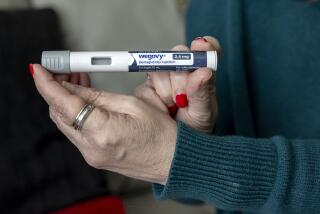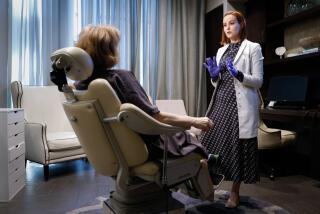Weight-Loss Device Spurs High Hopes
A recently approved weight-loss device that wraps around the stomach like a belt is being touted as a major advance in obesity surgery, even as some question the product’s effectiveness.
The unusual Lap-Band gastric belt is expected to spur sales at its Santa Barbara maker, Inamed Corp., which is seeing a slowing in revenue growth for its breast implant and plastic surgery products.
Sales of the Lap-Band in Europe, where Inamed has only one competitor, have been increasing since the product was introduced there in 1994. No one else sells a similar device in the U.S.
The Food and Drug Administration’s approval of the Lap-Band puts the company in the $1-billion market for weight-loss surgeries that help some 11 million Americans who are classified as severely obese for being more than 100 pounds overweight.
One industry analyst believes that the Lap-Band, which involves a less invasive procedure than stomach-stapling or gastric-bypass operations, could bring Inamed $100 million in revenue by 2003.
“This is the major development we’ve been waiting for,” said analyst, John Calcagnini of CIBC World Markets in Los Angeles.
Despite facing such risks as heartburn, vomiting and band slippage, patients already are asking for the band. One Newport Beach physician involved in clinical trials of the product said he is getting 10 calls a day from prospective patients.
“People are very excited by the fact that they can have an operation for weight control without rearranging their intestines,” said Dr. Brian Quebbemann, a surgeon who runs weight-loss clinics in Newport Beach and Irvine. He expects to handle 100 operations by the end of the year.
But the Lap-Band is only part of the reason Inamed’s stock has risen 25% this year while stocks of advanced medical-device companies in general have fallen nearly 10%. The company now controls half the U.S. market for breast implants and 90% of the market for collagen, which is used to help iron out wrinkles.
The belt product should secure Inamed’s return from the brink of disaster three years ago, when it was mired in costly litigation over breast implants, a Securities and Exchange Commission investigation into claims it inflated earnings and its delisting from the Nasdaq Stock Market. Cash was so tight then that Inamed sometimes failed to make payroll.
Its revival also could spell the end of daily control for Chairman and Chief Executive Richard G. Babbitt. He and lawyer Ilan Reich, who was president before he left in January, were hired three years ago to save the company.
“The guys who came in here did a great job turning things around,” said Thomas J. Gunderson, a U.S. Bancorp Piper Jaffray analyst. “Now the baton has to be passed to somebody who understands medical devices to take it to the next level.”
The company said only that it is looking to replace Reich.
Whoever comes on board will join a firm that has created a buzz in the U.S. medical device arena with the Lap-Band, fueled partly by news reports about the FDA’s approval. In a weight-conscious country, where obesity is viewed as a health risk and an unflattering statement on the condition of society, diet drugs and fads are a constant presence in the media and in everyday conversation.
But for severely obese people, the methods to cut away fat are often risky because they involve complex surgery. Stomach stapling is still used, but gastric bypass operations have become more popular. In bypass surgery, a large part of the stomach is sealed off and made inactive. Side effects, however, range from hair loss to malnutrition. Death may occur in rare cases.
The idea behind all such surgeries, including that for the Lap-Band, is to lessen the amount of food eaten.
The Lap-Band, placed around the upper portion of the stomach to form a pouch about the size of a golf ball, gives the patient a feeling of being full after eating less. The band’s inner tubing can be inflated with saline as the patient loses weight.
“As unappealing as the Lap-Band procedure is, it’s less unappealing than the alternatives,” such as gastric bypass surgery, said Gunderson, who upgraded his rating of Inamed stock to “buy” from “neutral” a day after the FDA’s approval.
Ellen Duke, who heads Inamed’s BioEnterics Corp. subsidiary, has helped promote the product since joining the unit in 1991.
“I realized that if we could make this work, the Lap-Band would reduce pain, hospital stays and even the number of deaths” from then-available surgeries, Duke said. “There was this sense we had something very precious on our hands.”
Patients typically can go home from the hospital in one or two days instead of the two to five days required by more involved obesity operations, the company said. The device and the surgery cost $14,000 to $24,000.
The Lap-Band is hardly risk-free. Nearly 90% of American patients in clinical trials had some side effects. About one-quarter of them had the instrument removed.
The device also has fostered its share of critics. Miriam Berg, president of the Council on Size and Weight Discrimination in Mt. Marion, N.Y., said overweight people would be better off exercising and eating well than going under the knife.
And Dr. Harvey Sugerman, a Virginia Commonwealth University professor who oversaw some clinical trials, said patients lost more weight from the gastric bypass procedure. “The Lap-Band just doesn’t seem to cut it,” he said.
Patients who had gastric bypass surgery lost nearly twice as much weight as those with the Lap-Band, one U.S. study concluded.
Still, losing 20 pounds in seven weeks with the Lap-Band makes Kelly Landeros, 27, feel as if she’s “getting my old self back.” The 5-foot, 10-inch Moreno Valley homemaker had grown to more than 300 pounds after bearing three children. She said she now has hopes of shrinking from a size 26 to a size 12.
Inamed said it plans to roll out the Lap-Band to about 100 clinics across the country by year’s end.
For Babbitt and Inamed, the FDA’s approval of the Lap-Band comes at a time when the company’s comeback efforts hit a plateau. Last year’s $37-million profit was down slightly from the previous year. Though sales have risen each year and hit $240 million last year, the company is seeing the breast implant market level off and the collagen market fall because of fears over “mad cow” disease.
Collagen typically is made from cow tissue, and Europeans especially are steering clear of cow-related products. The firm is working on a human-tissue collagen to allay fears and rebuild its market.
Last year, breast implant products accounted for 60% of Inamed’s revenue, while collagen and related products accounted for 32%. Foreign sales of the Lap-Band made up 8% of the revenue, with about 60,000 sold in Europe in seven years.
Babbitt wasn’t so sure about the company’s prospects when he and Reich arrived in January 1998. “There was a real fear Inamed wouldn’t survive,” he said.
The firm was a shambles, having lost $65.4 million in the previous seven years and fighting tens of thousands of lawsuits over allegedly defective silicone breast implants. (Its implants now are mostly saline-filled.) The firm also faced a lawsuit for the actions of a former executive who allegedly moved money in improperly from another company.
With Babbitt working the businesses, Reich spearheaded a global settlement of the breast implant cases for $32.4 million, removing a major impediment to the company’s ability to raise money. With the case settled, the company picked up financing to buy Collagen Aesthetics Inc. in Palo Alto for $155 million.
The company also settled with the SEC, reined in more than two dozen units to centralize operations in three major divisions and fired about 100 employees, or 15% of its work force, to cut costs. It also got its stock re-listed on Nasdaq, where it closed Friday at $28.31, up $3.36 cents a share.
(BEGIN TEXT OF INFOBOX / INFOGRAPHIC)
Shrinking Stomach
In a new weight-loss procedure, a band is wrapped around the stomach to create a smaller upper stomach that fills quickly and makes the wearer feel full, according to the manufacturer. The system, called Lap-Band, is intended for severely obese patients.
*
1. Four to six small incisions are made between rib cage and navel for tubes holding camera and surgical equipment.
*
2. Inflatable balloon temporarily placed in upper stomach to determine placement of band.
*
3. Band placed around upper stomach, to form golf-ball-sized pouch or smaller.
Source: BioEnterics Corp.
More to Read
Inside the business of entertainment
The Wide Shot brings you news, analysis and insights on everything from streaming wars to production — and what it all means for the future.
You may occasionally receive promotional content from the Los Angeles Times.










